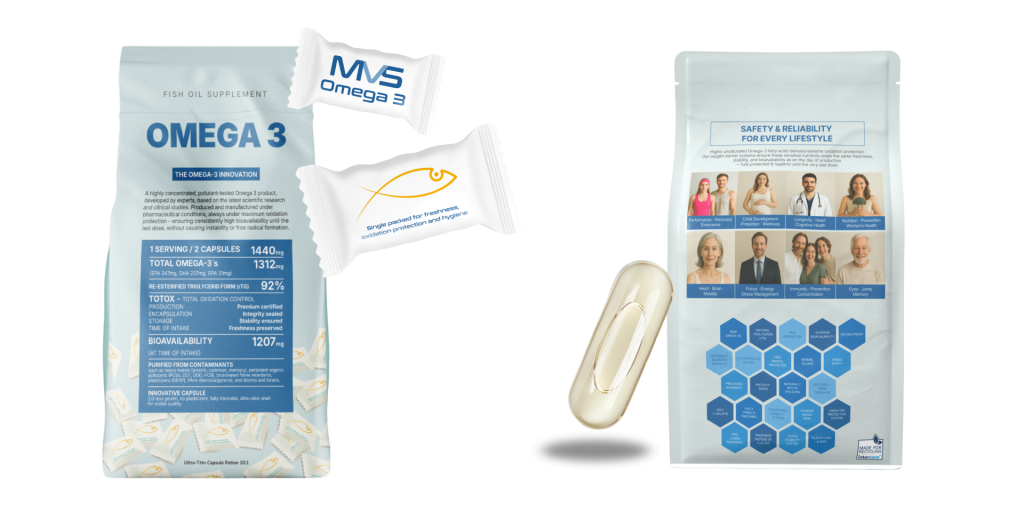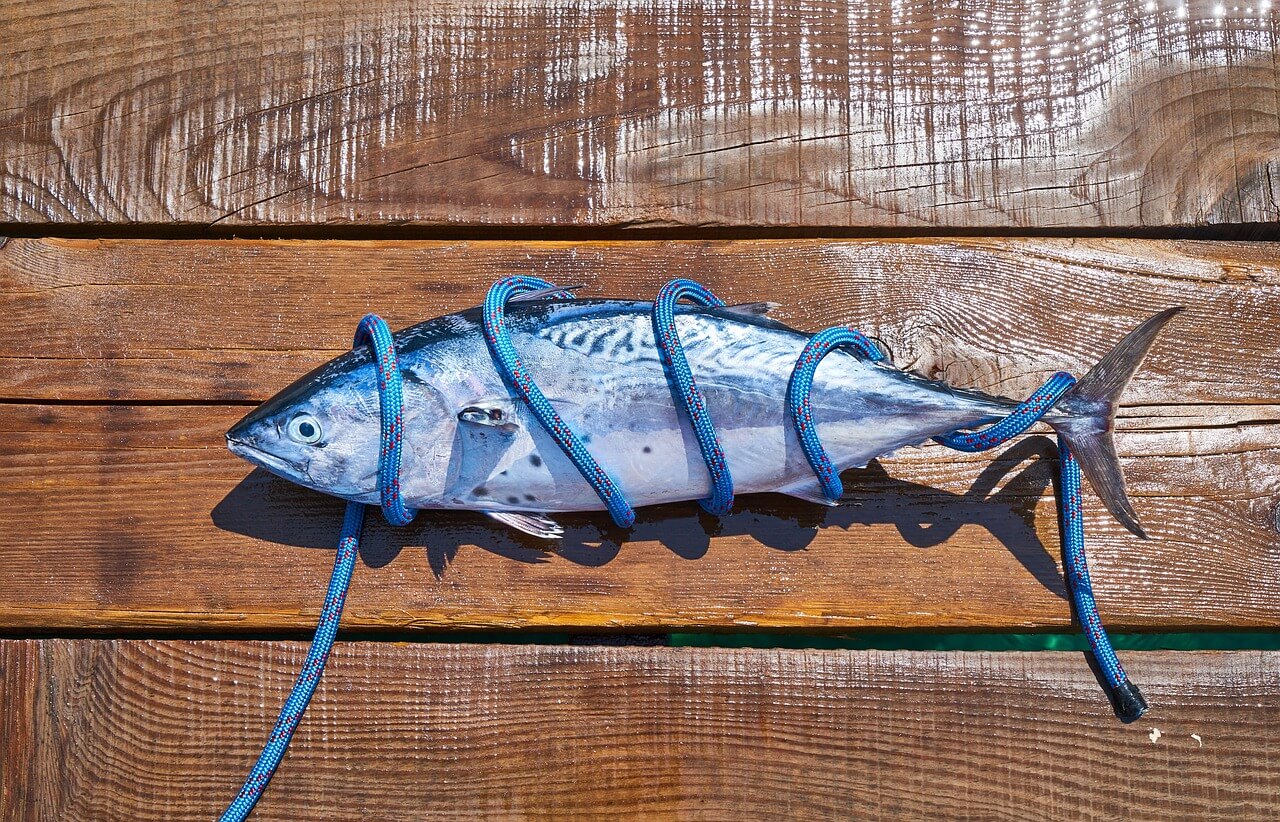Table of Contents
The Hidden Problem: Rancidity in Fish Oil Supplements
Fish oil is one of the most widely used dietary supplements worldwide, valued for its EPA and DHA Omega-3 fatty acids that support the heart, brain, eyes, and immune system. Yet fish oil has a critical vulnerability: it is highly unstable. When exposed to oxygen, heat, or light, it undergoes oxidation, leading to rancidity.
Rancid fish oil doesn’t just smell and taste unpleasant — it may lose its health benefits and even generate harmful compounds. Alarmingly, independent testing from 2023–2024 revealed that over half of commercial fish oil products exceed accepted oxidation limits.
This guide explores what rancidity is, why it matters for your health, how to detect it, and how modern innovations, such as our revolutionary MVS Omega-3 product — utilizing double packaging and oxidation resistance — are solving the problem.
What Is Rancidity in Fish Oil?
Rancidity occurs when fragile EPA and DHA molecules react with oxygen. This sets off a chain of oxidative reactions:
- Primary oxidation → fatty acids form lipid peroxides.
- Secondary oxidation → breakdown into aldehydes, ketones, and volatile compounds.
- Tertiary oxidation → advanced byproducts that alter smell, taste, and even color.
These changes are measured by industry tests like:
- Peroxide Value (PV) → early-stage oxidation.
- Anisidine Value (AV) → secondary oxidation.
- TOTOX value (Total Oxidation) → overall freshness.
High TOTOX = rancid oil. The lower the value, the fresher the fish oil.
Why Rancidity Matters for Health
- Reduced Effectiveness: Oxidized oils lose their ability to integrate into cell membranes or produce specialized pro-resolving mediators (SPMs) — meaning you don’t get the cardiovascular, cognitive, or anti-inflammatory benefits you expect.
- Pro-Oxidant Effects: Instead of lowering oxidative stress, rancid oils may increase it. Aldehydes and secondary oxidation compounds can damage cells and tissues.
- Digestive Side Effects: Fishy burps, nausea, or indigestion are common signs of rancid oils.
- Potential Long-Term Risks: Animal studies link oxidized oils to vascular damage and cholesterol disturbances. Human data is still emerging, but experts agree that rancid oils should be avoided.
How Common Is Rancidity?
Independent global surveys find 20–60% of fish oil supplements exceed safe oxidation limits. Some companies mask rancidity with lemon or mint flavors, giving a false impression of freshness.
Bulk-packaged oils (hundreds of capsules in a single bottle) are the most vulnerable, as every opening exposes all capsules to oxygen.
Fish vs Fish Oil Supplements: Safety Comparison
Consumers often wonder: “Is eating fish safer than taking supplements?”
Studies show that a person eating ~400 g of contaminated fish weekly may ingest 70 times more PCBs and 120 times more pesticides than someone supplementing with 1.5 g/day of purified fish oil.
- Fish consumption: A valuable source of Omega-3s, but may expose people to contaminants like mercury, PCBs, and dioxins — especially with large predatory fish.
- Fish oil supplements: When produced under strict quality control, contaminants can be removed through molecular distillation.
- Key difference: Freshness and rancidity. Without proper packaging and oxidation control, even purified fish oil can become harmful.
Are Fish Oil Supplements Safer Than Eating Fish?
While fish have long been hailed as a cornerstone of a healthy diet, recent alarms regarding the pervasive contamination of fish by mercury, PCBs, and dioxins have left health-conscious consumers at a crossroads.
The question arises: how can one harness the health-enhancing benefits of marine omega-3 fatty acids without exposing the body to potential toxins? In the past decade, a surge in the adoption of fish oil supplements has addressed this dilemma, offering a means to boost the body’s omega-3 fatty acid levels without the associated risks of environmental pollutants.
Researchers from Brigham and Women’s Hospital and Harvard Medical School in Boston conducted a comprehensive analysis of five brands of fish oil supplements, revealing that levels of PCBs and organochlorine pesticides were consistently below the detectable limit across all tested brands.
The conclusions drawn by the study authors:
The conclusions drawn by the study authors are profound: If an individual were to adhere to the optimal recommended amount of consuming fish from the Great Lakes—approximately 400 grams per week—they would potentially ingest a staggering 70 times more PCBs and 120 times more organochlorine pesticides compared to supplementing with the average daily dose of fish oil (1.5 grams) for one week. These findings underscore the remarkable safety profile offered by fish oil supplements in mitigating exposure to these contaminants when compared to traditional dietary sources.
-
Why are fish oil supplements so popular?
Omega-3 supplements provide a convenient and concentrated source of EPA and DHA, offering higher bioavailable doses than most diets. They deliver the benefits of fish oil without the need for regular seafood consumption and are purified to remove heavy metals and pollutants. This makes them a safe and effective way to support cardiovascular, brain, inflammatory, and prenatal health.
However, popularity brings responsibility: not all supplements are equal in purity, freshness, and stability.
Contaminants and Standards
Fish oil can be contaminated with mercury, arsenic, PCBs, pesticides, and microplastics. To ensure purity and safety, advanced purification methods like molecular distillation, vacuum processing, and nitrogen flushing are used. Quality is further guaranteed through compliance with IFOS and GOED standards, which set strict limits for contaminants and oxidation levels (TOTOX below 26, ideally between 5–10).
Consumers should seek supplements tested under these standards.
-
How to Detect Rancid Fish Oil
Consumer Clues:
– Strong fishy smell or aftertaste.
– Repeated “fish burps.”
– Discolored, cloudy, or sticky capsules.Professional Testing
– Peroxide value (PV) → early spoilage.
– Anisidine value (AV) → advanced oxidation.
– TOTOX → combined freshness index.
If brands don’t disclose these values, it’s a red flag.
Preventing Rancidity: Industry Solutions (2025)
- Purification under low-heat, vacuum distillation.
- Nitrogen flushing to remove oxygen during encapsulation.
- Cold-chain logistics to maintain stability through distribution.
- Protective forms: rTG form is both more bioavailable and more stable than ethyl ester oils.
- Packaging innovations:
- Blister packs (individual capsules).
- Double-layer packaging (capsule + oxygen-proof pouch).
- Light- and UV-blocking materials.
Summary: Rancidity Is the True Quality Divider
Fish oil can deliver life-changing benefits — but only if it’s fresh. Rancidity turns a healing nutrient into a harmful one.
- Fresh fish oil = effective, safe, beneficial.
- Rancid fish oil = degraded, unpleasant, potentially harmful.
- The solution: choose products with transparent testing, rTG form, and advanced packaging.
In 2025, the difference between a supplement that helps and one that harms comes down to oxidation exposure and rancidity control.
MVS Omega-3 — Setting a New Standard in Purity, Stability, and Bioavailability
Developed by MVS Pharma’s medical and pharmaceutical experts, MVS Omega-3 represents a new generation of scientifically designed Omega-3 supplements. With a 92% natural rTG structure, verified bioavailability of 1207 mg, and our proprietary T-TOX™ oxidation control system, it ensures exceptional purity, stability, and absorption. Each batch meets European Pharmacopeia standards and is tested for over 20 potential contaminants — setting a benchmark for transparency and trust in modern nutritional science.

Not all Omega-3 supplements are created equal. The more unsaturated and effective Omega-3 molecules become, the more sensitive they are to air exposure — making oxidation protection the single most critical factor for preserving both safety and bioavailability. Once oxidation begins, oil turns rancid, loses efficacy, and may even generate free radicals.
At MVS Pharma, this challenge defined our mission. We engineered MVS Omega-3 as a next-generation formulation designed for uncompromised purity, verified stability, and maximum biological usability.
Key Facts:
- Pharma-Standard Purification & Testing — each batch is verified to meet European Pharmacopeia standards and is screened for over 20 contaminants, including heavy metals, PCBs, dioxins, PAHs, and plasticizers.
- 90% Purified Omega-3 Concentration — delivering 1440 mg total oil with 1312 mg active Omega-3s (EPA 784 mg, DHA 518 mg) per serving.
- 92% Re-esterified Triglyceride (rTG) Form — structurally identical to natural fish oil for superior absorption (1207 mg bioavailable) and full physiological compatibility.
- T-TOX™ Total Oxidation Control System — exclusive German oxidation-management technology ensuring freshness and molecular integrity from production to the last capsule.
- Innovative Double Packaging — Individually Sealed Protection. Each capsule is individually sealed in an oxygen-free, double-wrapped container filled with argon gas. This advanced protective solution shields the sensitive Omega-3 oil from oxidation, light, and moisture — preserving the purity, stability, and freshness of each capsule until the very last dose.
- Ultra Thin Capsule Release 3.0™ — 2/3 less gelatin, no plasticizers, and >91% active ingredient load for transparency, purity, and optimized payload.
- Natural Tocopherol Matrix (α, β, γ, δ) — balanced antioxidant system calibrated to protect high-purity oil without destabilization.
The result is an ultra-pure, oxidation-protected Omega-3 supplement that maintains its natural structure, freshness, and full efficacy until the final dose — ensuring consistent support for cardiovascular, cognitive, visual, and immune health.
Disclaimer: As a service to our readers, MVS Pharma GmbH publishing provides access to our library of archived content in our blog. Please note the date of the last review or update on all articles. No content on this site should ever be used as a substitute for direct medical advice from your doctor or other qualified clinician.
FAQs
-
What does rancidity in fish oil mean?
It’s when fragile EPA/DHA fats oxidize, producing harmful byproducts that cause smell, taste, and quality loss.
-
Is rancid fish oil harmful?
Yes. It reduces benefits and may increase oxidative stress or cause digestive issues.
-
How common is rancidity in supplements?
Latest studies (2024-2025) show up to 60% of products exceed safe oxidation limits.
-
How can I tell if my fish oil is rancid?
Fishy smell, burps, taste, or discolored capsules are strong indicators.
-
What’s the best way to prevent rancidity?
Look for individually sealed capsules, oxygen-barrier packaging, and published oxidation values.
-
Does lemon flavoring mean freshness?
No. It is often used to mask rancidity instead of preventing it.
-
Which Omega-3 form is most stable?
Re-esterified triglyceride (rTG) form offers both stability and superior absorption.
-
Why are supplements safer than some fish?
Purification removes contaminants, but only fresh, properly packaged supplements are truly safe.
-
What’s the TOTOX value?
A freshness measure combining peroxide and anisidine values, depicting the oxidation marker of an omega-3 supplement. The lower, the better (< 5–10 is excellent).
-
What makes MVS Omega-3 different?
It offers oxidation resistance, superior absorption in rTG form, full safety testing, and double protection packaging — ensuring purity and potency from production to consumption.
Sources:
- Erratum to “Response to Bannenberg and Rice” Nutrition Reviews, nuab037
- Nutrition Reviews, Volume 79, Issue 12, December 2021, Page 1394
- Melanson SF, Lewandrowski EL, Flood JG, Lewandrowski KB. Measurement of organochlorines in commercial over-the-counter fish oil preparations: implications for dietary and therapeutic recommendations for omega-3 fatty acids and a review of the literature. Arch Pathol Lab Med. 2005
- Medical Press – “Tests find many popular omega 3 supplements are rancid”
- National Library of Medicine – “A Multi-Year Rancidity Analysis of 72 Marine and Microalgal Oil Omega-3 Supplements”


